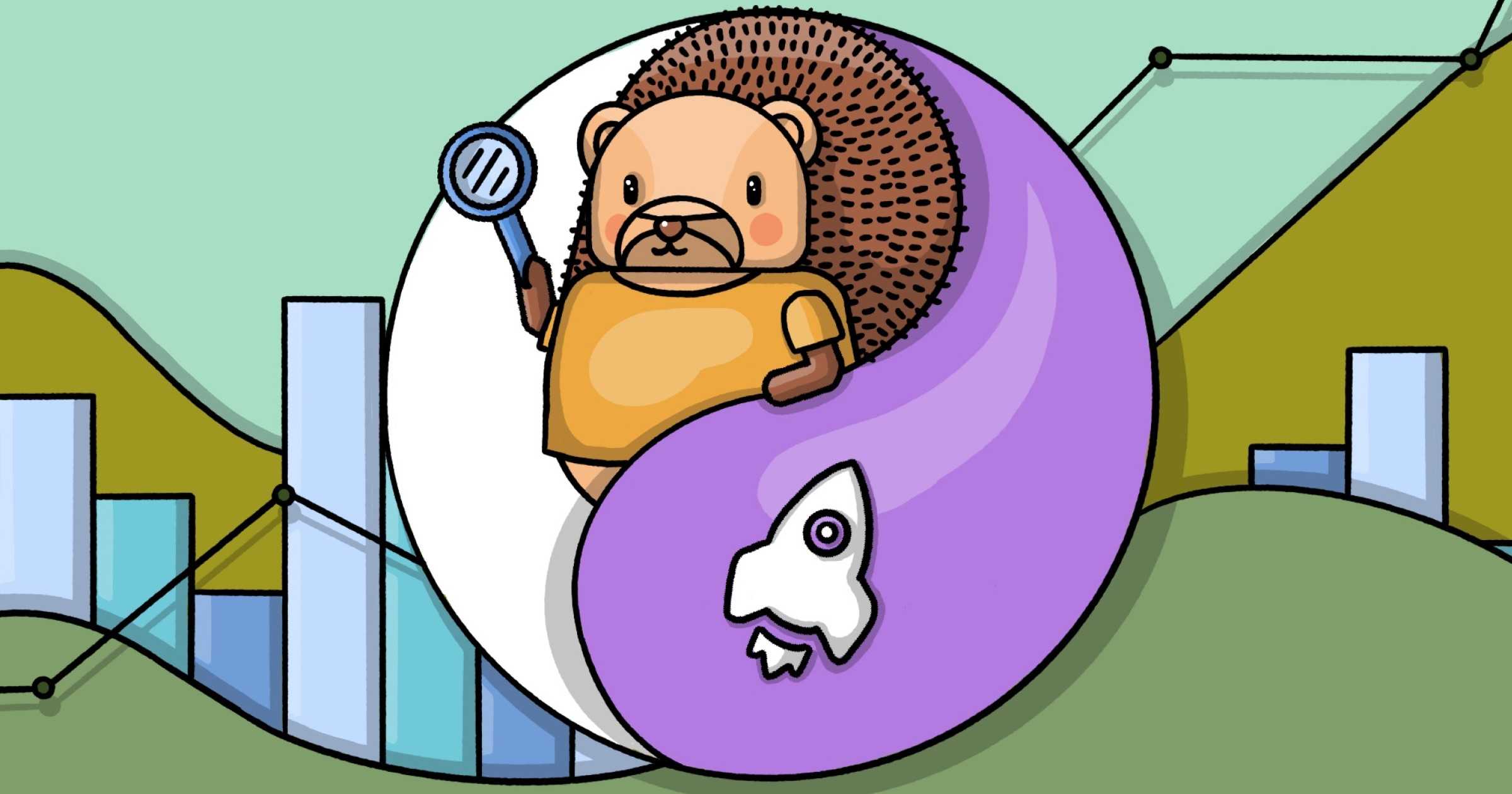In-depth: PostHog vs LogRocket
Jan 11, 2024

On this page
- How is PostHog different?
- 1. PostHog replaces multiple tools
- 2. PostHog is open source and transparent
- 3. PostHog constantly ships new features
- Comparing PostHog and LogRocket
- Product analytics
- Session replay
- Heatmaps and click tracking
- Tracking & SDKs
- Library support
- Data pipelines
- Popular integrations
- Compliance
- Frequently asked questions
- How much does PostHog cost?
- How can I estimate my usage?
- Does PostHog block bots by default?
- What about ad blockers?
- Can I use PostHog with a CDP? (Segment, Rudderstack, etc.)
Wnat to know how PostHog and LogRocket compare? If you remember nothing else, remember these two things:
LogRocket is a frontend monitoring tool that helps developers detects and solve issues.
PostHog goes beyond just frontend monitoring by integrating powerful analytics, session replay, feature management, A/B testing tools into one platform.
How is PostHog different?
1. PostHog replaces multiple tools
LogRocket is a narrow tool. It does one thing – and it does it well. PostHog includes many of the same tools, such as session replay, error tracking, and console logs, but augments them with powerful product and data tools, such as product analytics, feature flags, A/B testing, and surveys. It's everything you need to both squash bugs and understand every aspect of user behavior.
2. PostHog is open source and transparent
PostHog is built with transparency at its core. Not only do we work in the open and give full access to our source code, we also enable developers to build their own integrations, open their own PRs, or give feedback on our roadmap. PostHog's open app framework makes it easy to integrate internal tools, an advantage closed-source products like LogRocket can't offer.
3. PostHog constantly ships new features
We ship weirdly fast. We update our changelog every week and often there’s even more features in beta testing. And that’s without counting all the apps and integrations submitted by our community! We work hard to keep PostHog on the cutting edge and we’re transparent about the ways we do that.
Comparing PostHog and LogRocket
| LogRocket | PostHog | |
Product analytics Track events and conversion; analyze user behavior | ✔ | ✔ |
Session replay Watch real users use your product; diagnose bugs | ✔ | ✔ |
Feature flags Roll out features safely; toggle features for cohorts or individuals | ✖ | ✔ |
Surveys Ask users for qualitative feedback and gather responses | ✖ | ✔ |
Experiments Test changes and analyze impact | ✖ | ✔ |
Heatmaps Track where users click | ✔ | ✔ |
Event pipelines Push and pull data to enrich customer profiles | ✔ | ✔ |
Open source Build your own apps and contribute code | ✖ | ✔ |
Feature flags: PostHog offers robust, multivariate feature flags which support JSON payloads. This enables you to push real-time changes to your product without needing to redeploy. Visit our feature flag page for more information. LogRocket doesn’t have any in-built feature flag functions.
Experiments: PostHog offers multivariate experimentation, which enables you to test changes and discover statistically relevant insights. Visit the experimentation page for more information. LogRocket doesn’t have any in-built experimentation features.
Product analytics
While LogRocket offers some product analytics features, it isn’t primarily intended as an analytics platform and lacks many things product managers and engineers require. PostHog is a more capable product analytics platform, offering advanced features such as correlation analysis, custom formulas, and a flexible SQL query editor.
| LogRocket | PostHog | |
Graphs and trends Build custom insights and visualizations | ✔ | ✔ |
Dashboards Combine insights into shareable dashboards | ✔ | ✔ |
Funnels Understand conversion between events, pages | ✔ | ✔ |
Cohorts Combine users based on properties and events for group analysis | ✔ | ✔ |
User paths Track user flows and where they drop-off | ✔ | ✔ |
Retention Analyze user and revenue retention | ✔ | ✔ |
UTM tracking Track marketing campaigns with UTM tags | ✔ | ✔ |
Correlation analysis Suggested events and properties that lead to success or failure | ✖ | ✔ |
Group analytics Understand how organizations use your product | ✖ | ✔ |
Formulas Use custom formulas to calculate unique insights | ✖ | ✔ |
SQL query editor Write your own queries in SQL | ✖ | ✔ |
- Correlation analysis: This feature enables you to automatically find correlated events or properties which affect the conversion rate of users within a funnel. LogRocket doesn’t offer any such automated correlation discovery, meaning users must search for correlating factors manually and without assistance.
Further reading: Comparing the most popular LogRocket alternatives
Session replay
LogRocket and PostHog both offer robust, full-featured session replay tools that outperform even dedicated tools, such as Hotjar.
| LogRocket | PostHog | |
Web app recordings Capture recordings from single-page apps | ✔ | ✔ |
Mobile app recordings Capture recordings in iOS and Android apps | ✔ | Beta |
Identity detection Link recordings to user IDs | ✔ | ✔ |
Console logs Capture extra content from a users’ browser environment | ✔ | ✔ |
Playlists Sort recordings into static and dynamic playlists | ✔ | ✔ |
Performance monitoring Track network events within a session | ✔ | ✔ |
Privacy masking Censor personal information from playback | ✔ | ✔ |
Conditional recording Only capture the sessions you want | ✔ | ✔ |
Export recordings Take recordings in/out of the platform | ✔ | ✔ |
- Mobile app recordings: Session replay for mobile apps is currently under development – see our GitHub mega issue for more.
Heatmaps and click tracking
LogRocket’s heatmap and click tracking functionality exceeds PostHog’s and enables you to visualize more precisely how users interact with your site at the aggregate level. PostHog’s toolbar focuses on visualizing clicks, and enabling users to quickly track such events within product analytics.
| LogRocket | PostHog | |
Heatmaps Visualize cursor movements on a page | ✔ | ✖ |
Clickmaps Visualize where users click on a page | ✔ | ✔ |
Scrollmaps Visualize how far down a page users scroll | ✔ | ✖ |
Eyetracking Visualize precisely where users are looking on a page | ✖ | ✖ |
Tracking & SDKs
Tl;dr: Both support a broad range of tracking options and libraries, and manual event instrumentation, as well as autocapture.
| LogRocket | PostHog | |
Event tracking Track manually instrumented events | ✔ | ✔ |
Autocapture Automatically track events without instrumentation | ✔ | ✔ |
Combined events Track related events as a single trackable action or behavior | ✔ | ✔ |
Reverse proxy available Send events from your own domain to capture more data | ✔ | ✔ |
Cross-domain tracking Track users across domains and sub-domains | ✔ | ✔ |
Server-side tracking Send events from your server | ✔ | ✔ |
Capture API Send events through an API | ✔ | ✔ |
Library support
PostHog supports a wide range of client and server libraries, but not all features are equally available across all of them. We recommend using PostHog's JavaScript snippet to enjoy all our features. See our client library documentation for more information.
| LogRocket | PostHog | |
JavaScript | ✔ | ✔ |
React Native | ✔ | ✔ |
React | ✔ | ✔ |
Flutter | ✖ | ✔ |
iOS | ✔ | ✔ |
Android | ✔ | ✔ |
Ruby | ✖ | ✔ |
Data pipelines
PostHog offers more than 50 integrations and apps, while LogRocket offers slightly fewer. As an open-source application, PostHog welcomes contributions from the community. If an integration you need isn’t available, it’s possible to create it!
| LogRocket | PostHog | |
Export API Export data via API | ✔ | ✔ |
Import API Import data via API | ✔ | ✔ |
Amazon Redshift Export data to Redshift | ✖ | ✔ |
Amazon S3 Export data to S3 bucket | ✖ | ✔ |
Azure Blob Storage Export data to Microsoft Azure | ✖ | ✔ |
Google Cloud Storage Export data to GCS | ✖ | ✔ |
Snowflake Export data to Snowflake database | ✖ | ✔ |
BigQuery Export data to Google BigQuery for analysis | ✖ | ✔ |
RudderStack Sync event and person data | ✖ | ✔ |
Airbyte Extract and load data to external platforms | ✖ | ✔ |
Popular integrations
Below, we've listed a few of the most popular integrations used across PostHog and LogRocket. See our app directory for a full list.
| LogRocket | PostHog | |
Hubspot Sync event and person data | ✖ | ✔ |
Salesforce Sync event and person data | ✔ | ✔ |
Zapier Export events for use in Zaps | ✖ | ✔ |
Stripe Sync customer and invoice data | ✖ | ✔ |
Intercom Extract and load data to external platforms | ✔ | ✔ |
Customer.io Sync data between platforms | ✖ | ✔ |
Sentry Ingest Sentry errors for analysis | ✔ | ✔ |
Segment Ingest events from Segment | ✔ | ✔ |
Compliance
Regulatory compliance can be make-or-break for many teams, especially those operating in fields such as healthcare or the financial sector. Luckily, LogRocket and PostHog both offer a variety of ways to comply with such regulations.
| LogRocket | PostHog | |
GDPR ready | ✔ | ✔ |
HIPAA ready | Self-host only | ✖ |
Data anonymization | ✔ | ✔ |
Cookie-less tracking option | ✖ | ✔ |
SOC 2 certified | ✔ | ✔ |
SAML/SSO available | ✔ | ✔ |
2FA available | ✔ | ✔ |
Frequently asked questions
Got another question? You can ask the PostHog team anything you want!
How much does PostHog cost?
PostHog has transparent pricing based on usage with a generous free tier:
| Free usage per month | |
|---|---|
| Product analytics | 1 million events |
| Session replay | 5,000 recordings |
| Feature flags | 1 million API requests |
| A/B testing | 1 million API requests |
| Surveys | 250 responses |
We charge progressively less the more you use once you exceed your monthly free allowance. Volume, non-profit and startup discounts are also available.
How can I estimate my usage?
The easiest way is to sign up to PostHog, integrate our snippet, then check the projection on your billing page after a few days. Alternatively, you can guesstimate by multiplying your current monthly active users by an estimate of events generated per user – 50 to 100 per user is a good starting point. See Estimating usage & costs in our docs for more.
Does PostHog block bots by default?
Yes. See the full blocklist in our docs.
What about ad blockers?
We recommend all users deploy a reverse proxy, which enables you send events to PostHog Cloud using your own domain. Events sent from your own domain and are less likely to be intercepted by tracking blockers, ensuring you capture the best data possible. We have reverse proxy setup guides for AWS Cloudfront, Caddy, Cloudflare, Netlify, Vercel, and more, in our docs.
Can I use PostHog with a CDP? (Segment, Rudderstack, etc.)
Yes. See Using PostHog with a CDP in our docs.
Ready to find out more?
